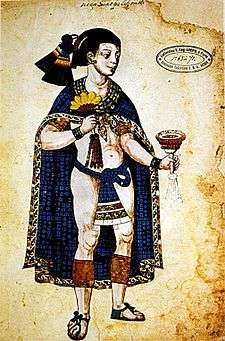Nezahualpilli
| Nezahualpilli | |
|---|---|
| Tlatoani of Texcoco | |
 A non-contemporary depiction of Nezahualpilli from the Codex Ixtlilxochitl. | |
| Reign | 1473–1515 |
| Predecessor | Nezahualcoyotl |
| Successor | Cacama |
| Born | 1464 |
| Died | 1515 |
| Issue |
Cacama Many other children |
| Father | Nezahualcoyotl |
Nezahualpilli (Nahuatl for "fasting prince"; 1464–1515) was ruler (tlatoani) of the Mesoamerican city-state of Texcoco, elected by the city's nobility after the death of his father, Nezahualcoyotl, in 1472.
Like his father, he was a poet, was considered a sage, and had the reputation of being a fair ruler. Only one of his poems survives: "Icuic Nezahualpilli yc tlamato huexotzinco" ("Song of Nezahualpilli during the war with Huexotzinco"). His court was a haven for astronomers, engineers, and soothsayers. During his reign, he abolished capital punishment for a number of crimes and struggled to keep the political independence of Texcoco during the increasing centralization of Aztec power in Tenochtitlán.
When he told Moctezuma II that the Texcocan wise men had foretold foreign dominion over the Valley of Mexico, the emperor challenged him to a ball game. Moctezuma considered the loss of the game a negative omen.[1][2]:15
He married a daughter of Ahuitzotl only to later have her executed. Her public improprieties and high social status qualified her for a punishment that would not have been applicable to someone of a lower status. He was said to have taken numerous consorts and fathered 144 children.
Nezahualpilli was succeeded by his son Cacama.
Notes
- ↑ Fehrenbach (1973), p.103
- ↑ León-Portilla, M. 1992, 'The Broken Spears: The Aztec Accounts of the Conquest of Mexico. Boston: Beacon Press, ISBN 978-0807055014
References
- Fehrenbach, T.R. (1973). Fire and Blood: A History of Mexico. New York: Macmillan.
External links
| Preceded by Nezahualcoyotl |
Tlatoque of Texcoco 1473–1515 |
Succeeded by Cacama |